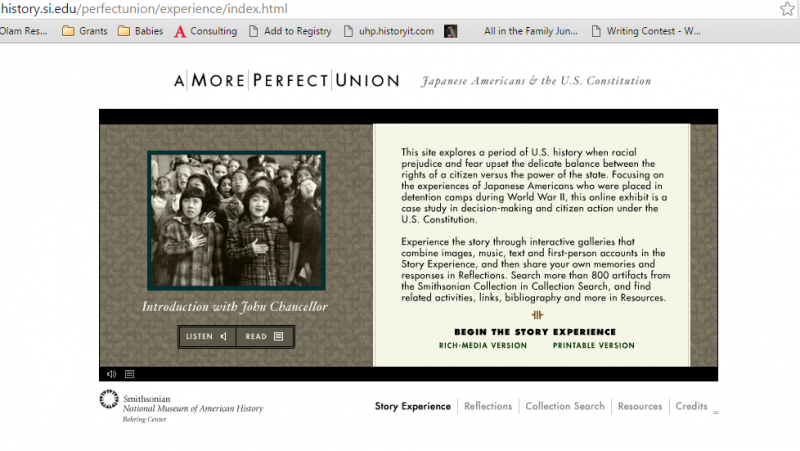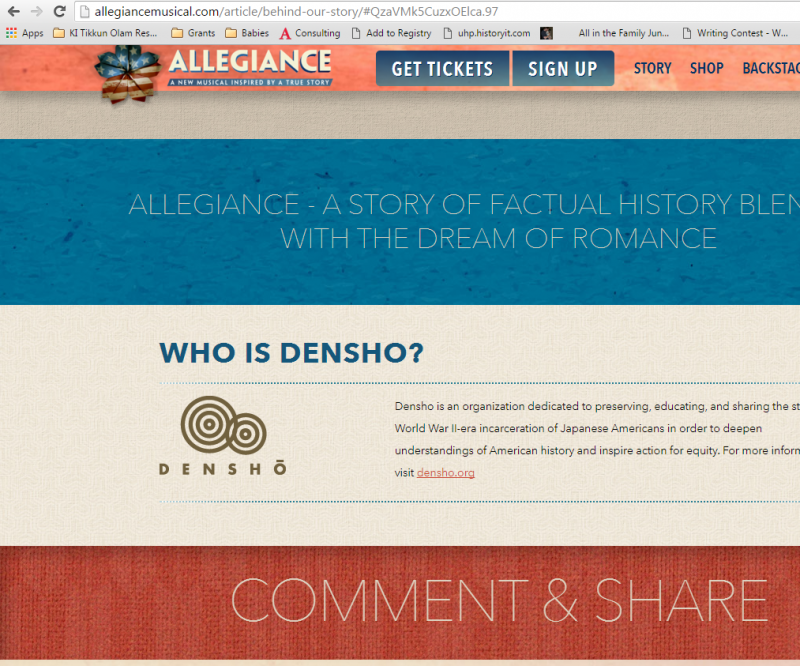Public history on Broadway (Part 2)
29 February 2016 – Adina Langer
theater, popular culture, methods, public engagement, memory, museums, oral history, music, exhibitions
My recent review of the Georgia Social Studies Standards, as part of my work at the Museum of History and Holocaust Education, galvanized my desire to reflect on the importance of the Broadway musical, Allegiance, which tells the story in fictionalized form of George Takei’s family’s experience in internment camps during World War II. This is the second part of my two-part post. See Part 1 here.

Screen shot credit: Smithsonian Institution
The November 2015 issue of The Public Historian, which focuses on auditory history, makes note of the power of sound to elicit memory. Museum’s often use sound in the form of oral history clips to connect visitors with participants in historical events. The Smithsonian Museum of American History’s 1987 exhibit, A More Perfect Union, mentioned in Part 1 of this piece, was one of the first to incorporate video clips from oral histories directly into the gallery experience[1]. Quoted in the Densho Encyclopedia article on the groundbreaking exhibit:
Selma Thomas, who conducted the original interviews and edited them for the final display explained that this format brought ‘the immediacy and intensity of a primary source that is instantly recognizable to museum audiences,’ while at the same time ‘the layers of narrative…also include the visitor’s own narrative, the background, questions, and expectations he/she brings to the installation and that lead him/her to select this informant and that question.’
Many museums stick to methods that underscore “authentic voices” through quotations or clips, but some have begun to incorporate more fluid performance techniques into their toolkit for audience engagement.
In their collection of essays, Enacting History, Scott Magelssen and Rhona Justice-Malloy present a number of case studies on living history, battle reenactments, pageants, festivals, and heritage tourism destinations, exploring questions of authenticity and representation. They argue that historical performances like these, regardless of their truth-telling claims, are an important means to “communicate, document, and even shape history, and allow for a level of participation and accessibility unique to performance.”
Any historical representation must be judged on its merits as both history and as a particular kind of cultural work. I recently saw an inspiring conference presentation by award-winning playwright Addae Moon of the Atlanta History Center on the principles of museum theater, including the difference between historical accuracy and historical plausibility. He explained that working only with “real” characters from the past can limit the ability of actors to connect with visitors, whether in the context of a gallery performance or an interaction with a costumed interpreter. Instead, the actors at the Atlanta History Center focus on historical plausibility, creating composite characters whose words and actions are appropriate for the historical role they are playing. Visitors are always brought in as equals of the character in order to enable them to gain an accurate understanding of the character’s perspective. For example, an actor playing an enslaved person will address visitors as if they, too, are enslaved people visiting from a neighboring plantation. Mr. Moon also emphasized the importance of drama, arguing that there must be a dilemma to solve or a problem to wrestle with. Without a dramatic hook, according to Moon, museum theater cannot accomplish the work of creating a memorable emotional connection for visitors.
Traditional theater does not have the luxury of establishing a special identity for members of the audience. Instead, a musical or play must create an immersive scene, transporting the audience to another time and place and melting away their current-day context. The goal is an affective experience for the audience. If there is a cognitive lesson to be learned, it must be learned through the affective emotional response.
Encountering Japanese internment through a show like Allegiance is bound to create a strong emotional response in any person unfamiliar with the idea of the incarceration of entire families. Even if audience members learned about Japanese internment in high school, seeing, and especially hearing, actors performing the drama of leaving home, losing their livelihoods, and making difficult decisions in a highly restricted environment resonates emotionally. This approach may be uncomfortable for many historians, but there is precedent for emotionally powerful (though often inaccurate) histories in popular culture having a lasting impact on the historical understanding of large swaths of the population. Just look at Birth of a Nation or Gone With the Wind. (The very popular Broadway musical Hamilton, [reviewed in The Public Historian this month and on this blog last Wednesday] and Ken Burns’ body of documentary work provide more recent examples.)

Courtesy “Behind Our Story” section of Allegiance website
The creators of Allegiance offer the following tagline for their show: A Story of Factual History Blended With The Dream of Romance. The show has garnered mixed reviews from newspapers and magazines, including Variety and The New York Times. The reviews have noted that the show’s strength lies more in its background history than in its power as a musical. Interestingly, the Variety review specifically called out the problem of using archetypes to try to “humanize” difficult historical material. “In their sincere efforts to ‘humanize’ their complex historical material, the creatives have oversimplified and reduced it to generic themes. . . . Complicated political issues are restricted to surface elements.”
I’m not a professional Broadway reviewer, but I enjoyed some of the scenes and songs immensely, and the ending moved me to tears. I believe that the musical environment of the show made me particularly sensitive to the drama of, and the political issues raised by, the story. Particularly notable were songs that incorporated authentic Japanese words and melodies, including one called Ishi Cara Ishi (sung by George Takei’s grandfather character), about moving mountains stone by stone; one called Gaman, about endurance with dignity; and an incredibly powerful untranslated song called Itetsuita, sung only by the cast of internees on the occasion of the dropping of the atomic bombs on Hiroshima and Nagasaki.
I know that this show left a lasting impression on me, and a glance around the theater after the performance revealed similar reactions among other audience members. Reviews on the show’s Facebook page, admittedly a self-selected cross-section, are almost universally positive and focus on the emotional power of the story and the honor of seeing someone who lived through this “dark time” in history performing a role to tell its story in a sensitive and timely manner.
I’ve advocated for the importance of passion to public history elsewhere on this blog, and I continue to believe that emotional connection is an important gateway to a deeper exploration of challenging historical subject matter. If public historians embrace emotional connection, and also come to understand better how it works, they can better counter inaccurate narratives brought to the fore through emotional exploitation. Like all powerful tools, emotional connection should not be used frivolously, but it should remain an important part of the public historian’s toolkit.
~ Adina Langer is the curator of the Museum of History and Holocaust Education at Kennesaw State University. You can follow her on Twitter @artiflection, and visit her on the web.
[1] See also: Anna Green, “The Exhibition that Speaks for Itself” and Toby Butler and Graeme Miller, “Linked,” both in Robert Perks and Alistair Thompson, eds., The Oral History Reader (New York: Routledge, 1998); Selma Thomas, “Private Memory in Public Space” and Senka Bozic-Vrbancic, “Scars in the Ground,” both in Linda Shopes and Paula Hamilton, eds., Oral History and Public Memories (Philadelphia: Temple University Press, 2008).



